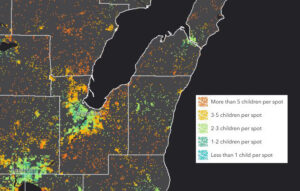
By Kris Leonhardt/Josephine Hinderman/Kaity Coisman
Press Times staff
As generational cycles occur, negative patterns and traits are known to transfer through multiple generations via learned behavior, family dynamics and environment. We continue to explore five northeast Wisconsin intergenerational family issues — physical health, alcoholism and drug use, mental health, education and housing — and what some organizations are doing to address the trends.
NORTHEAST WISCONSIN – Many high school graduates seek higher education to gain economic prosperity.
A November 2022 UW-Madison report on college-going rates for public high school students stated that “Wisconsin’s college-going rate typically hovers around 60%.”
During COVID that dropped below 50%.
“On average, college-going rates are typically 20 percentage points higher for white and Asian students than for American Indian, Black and Hispanic students,” the report further showed, and “college-going rates for non-economically disadvantaged students are about 27 percentage points higher rates than economically disadvantaged students.”
But, a college degree can turn things around for those at a disadvantage.
The U.S. Bureau of Labor Statistics said that those with a bachelors degree or higher had the lowest unemployment rate — at 2.2% — while high school graduates with no college education had an unemployment rate of 4.5%, based on February 2022 numbers.
However, pathways to that college education may seem daunting, due to limitations in college preparedness, family support, financial funding and low confidence in academic ability, especially if you are a first-generation student.
A first-generation student is defined as “one who is the first in their immediate family to attend or graduate from a four-year institution.”
UW-Green Bay said that in 2021, 34.2% (2,356) undergraduate students and 11.2% (51) graduate students were recognized as first-generation students — the first in their families to pursue a college degree.
Those numbers coincide with a national average of 33%, according to the U.S. Department of Education.
Post-secondary solutions
But, local colleges are working to make that pathway a little easier to navigate, especially for those trying to break the cycle.
In 2021, UW-Green Bay was designated as a First-gen Forward institution by the Center for First-Generation Student Success.
The First-gen Forward designation recognizes “institutions of higher education which have demonstrated a commitment to improving experiences and advancing outcomes of first-generation college students.”
As a First-gen Forward Institution, interested faculty and staff are provided multiple opportunities to engage with other institutions that are creating environments that improve the outcomes of first-generation students.
The CollegeReady Program — a partnership between UW-Green Bay, Northeast Western Technical College and the Green Bay Area Public School District — is dedicated to assisting first-generation students.
The program assists students financially and provides a supportive pathway to advance to that next step.
In May, the program saw 166 students complete their college readiness program, signing letters of intent with various colleges.
“Proving access to higher education for everyone who wants to learn is core to our mission. We are proud to be a First-gen Forward institution and welcome everyone who wants to continue to rise and work to achieve their goals,” UW-Green Bay Chancellor Michael Alexander said during the signing event.
Launched for the fall of 2023, the Wisconsin Tuition Promise works through the UW System to give underserved Wisconsin students a leg up so they may obtain a bachelor’s degree, specifically targeting first-generation students and low-income families earning less than $62,000 annually.
UW-Green Bay’s Rising Phoenix program provides high school students in rural districts of Northeast Wisconsin with access to dual credit services for their college education.
“Expanding Rising Phoenix to district partners in rural Wisconsin gives rural students who lack early college opportunities a jumpstart,” Chancellor Alexander explained.
“Preparing our students for their futures can be a challenging task for any district. That challenge is much greater for us, due to the barriers and obstacles that come with being Wisconsin’s smallest school district,” stated Washington Island Principal and Curriculum Director Timothy Verboomen. “Partnering with UW-Green Bay’s Rising Phoenix program for the rural district cohort offers our students access to opportunities that we hadn’t imagined possible.”
Not child’s play
Early care and education supports the cognitive and social-emotional development of young children.
Early childhood education is a critical first step to the child’s development, and northeast Wisconsin and the state as a whole struggle to keep up with the high demand and low availability of providers.
Quality education/care comes at a high cost, while providers and their staff struggle to make ends meet.
To meet YoungStar standards — Wisconsin’s child care quality rating program — costs rise, as staff is required to meet educational standards through training.
To assist the industry, the Child Care Counts program provided almost $600 million to nearly 5,000 providers from March 2020 to March 2023.
Gov. Tony Evers recently proposed making the program permanent, but the Joint Finance Committee voted to end the subsidy program in June.
“According to a survey of nearly 1,200 Wisconsin early care and education providers from the National Association for the Education of Young Children, more than 27% of providers reported that their program would have closed without the stabilization grants, and when the grants end, more than 60% of child care directors say they will have to raise tuition on families and another more than 33% say they will have to cut wages or will be unable to sustain wages/salary increases for their staff. According to Kids Forward, the median pay for child care workers in Wisconsin is $12.66 an hour,” a release from Evers office stated.
“Additionally, 54% of Wisconsinites today live in a child care desert — where there are few to no high-quality options for child care in their neighborhood or community — and even if there is a nearby child care provider, it still might not be affordable for a working family. According to the Annie E. Casey Foundation’s annual Kids Count report, the average yearly cost of center-based child care in Wisconsin is $12,415.”

The “Access to Child Care in Wisconsin” report, prepared by the Early Childhood Advisory Council in 2018, showed that northeastern Wisconsin was home to 71 child care deserts, which means 35.9% of the region did not have enough childcare facilities; that was before COVID-19.
But, lack of child care has other implications outside of education.
“Everywhere I go I see ‘Help Wanted signs,’” said Brown County resident, Charlie Frisk. “Finding help is already at a crisis point, what will happen when the parents of 87,000 children can no longer find affordable child care?
“During high school, my older daughter worked as a waitress in a very nice Green Bay restaurant. She told me she was the only waitress working there who was not a single mother. These are the workers that will go first when the cost of child care rises, or child care is simply not available.
“Eve’s Supper Club, the east side Los Banditos and Victoria’s Italian Restaurant all closed when they still had good business. The owners of all three restaurants cited the inability to find help as one of their major reasons for closing.”
Thinking outside of the box
Programs such as the Boys & Girls Club and Literacy Green Bay help fill the need for those outside of a school system.
The Boys & Girls Club offers a “Wisconsin After Three” program to address math and reading skills for youth.
Wisconsin Boys & Girls Club President Emeritus Karen DeSanto said that students in the program demonstrated a 13% increase in math proficiency — nearly doubled the projected growth of 7%.
The Boys & Girls Club’s “Be Great: Graduate” intervention program assists teens that are at risk of not graduating from high school.
“A teenage dropout costs taxpayers an average of $292,000 over a lifetime, so the thousands of teens we’ve helped graduate translates to millions saved by taxpayers,” DeSanto added.
Literacy Green Bay provides tutoring services for families to help with English, math, writing and computer skills.
“I say that what we do transforms lives,” said Literacy Green Bay Executive Director Robyn Hallet in an interview with Press Times staff. “This isn’t just a handout; we want to teach people ‘to fish,’ so to speak. Literacy must be learned and earned, and the people that come here are internally motivated.”
The program recently received two large grants to upgrade from eight classrooms to 20, which organizers say are at full capacity.
“A majority of our students are individuals of BIPOC (Black, Indigenous, People of Color) background, and most of them — approximately 97% — are low income,” Hallet added.
“We as a society need to change that.”
This story is part of the NEW (Northeast Wisconsin) News Lab’s fourth series, “Families Matter,” covering issues important to families in the region. The lab is a local news collaboration in northeast Wisconsin made up of six news organizations, which includes Green Bay Press-Gazette, Appleton Post-Crescent, FoxValley365, The Press Times, Wisconsin Public Radio and Wisconsin Watch. The University of Wisconsin-Green Bay’s Journalism Department is an educational partner. Microsoft is providing financial support to the Greater Green Bay Community Foundation and Community Foundation for the Fox Valley Region to fund the initiative. The mission of the lab is to “collaborate to identify and fill information gaps to help residents explore ways to improve their communities and lives — and strengthen democracy.”
